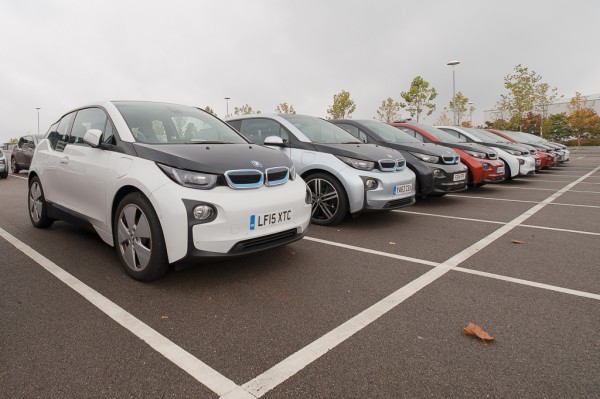
I’ve been test-driving electric and hybrid cars recently. I’ve tried the all-electric Renault Zoe and Nissan Leaf, and the plug-in hybrid Golf GTE. All of these are excellent cars, and a pleasure to drive. I’d recommend anyone thinking of a second car to have a look at them; a used Zoe with very few miles on the clock will set you back about £8000, and since Renault have a battery-leasing scheme you need to add about £4000 to that if you keep the car for five years. I enjoyed driving it. The Leaf is even better, but a bit bigger and more expensive – it’s a really nice car. The manufacturers have gone out of their way to make sure that driving one of these has as few surprises as possible for anyone used to any other vehicle. We’re thinking about a replacement for our main car, though, and we’re not quite ready to go all-electric for that. In 5 years’ time, that will be completely viable, but not yet, not for us.
So, ever since I heard first about the Golf GTE, I thought that might be the answer. Our current Golf has been probably the best car I’ve owned, the local dealer is very good, and this would let us venture into the hybrid/electric world while keeping our feet safely on the ground. And VW have some very nice extras like automatic parallel parking, and a good adaptive cruise control. When people talk about cruise controls I tend to think about motorway driving, but what’s possibly even cooler is its ability to keep you a constant distance from the car in front while crawling through slow-moving traffic. I really liked that.
But there’s a problem.

The problem is that in the middle of this process, I drove the BMW i3. For those of you not acquainted with the i3, it’s an electric car designed from the ground-up, built with various lightweight, innovative (and often recycled) materials, in a factory powered almost entirely by renewable energy, and so on. It’s quirky, and great fun, though it also comes with a BMW price tag. Ouch. Still, there are some used ones available now, and at least it’s not a Tesla.
But the i3 has an optional extra that almost everybody buys: the range-extender (known to the cognoscenti as the ‘REx’). This is a little 30HP 600cc engine tucked away below the boot which can charge the battery from a two-gallon petrol tank and extend the roughly 90 miles of normal electric range for another 90 miles, or, in fact, for as far as you like if you don’t mind stopping to fill up every hour and a half! So I could, if wanted, drive from here to the Lake District in the opposite corner of Britain with just a couple of stops even if all the (increasingly plentiful) electric charging points en route were full or inoperative.
So it’s not a true hybrid, in the sense that the engine is never intended to be the main thing driving the car. In fact, many owners use the REx so rarely that the car will switch it on briefly every few hundred miles just to keep it happy. But, for me, it’s the thing that lets you have an innovative and almost all-electric car and yet bridge the next few years until the charging infrastructure is more fully developed. And after driving it, other hybrids like the Golf seem, well, rather compromised: packing two full engines into a car that therefore only has an electric range of around 30 miles, when the 90 electric miles or so available from a more thoroughly-electric car would almost cover me for a typical week on a single charge. (This may be important, since I have no off-street parking at home.)
I like living in the future – or at least, trying to. (Shaw was right.) Even Rose, who’s an historian and likes living in the past, can see the attraction of this. Imagine you’re thinking of buying a boat. The sensible thing to get is a motor yacht, because it can go anywhere in almost any weather. But it’s so much more romantic, and beautiful, and pioneering, and quiet, and environmentally friendly, to get something with sails instead, even if you then have to plan a little bit more about where you can go, and when. Well, this is a sailing boat, but with an outboard motor, for when you need it, but with the added interesting twist that it can out-accelerate almost any other speedboat in the harbour.
So yesterday I went (with my friends Michael and Laura, who have one) to a gathering of i3 owners near Milton Keynes to find out more. There were about 34 i3s there, and a couple of i8s, which means the combined battery capacity was approaching a megawatt-hour. Your physics assignment for this morning is to work out what kind of fun things you could do if, say, you discharged all of that over five or ten minutes. (I’m thinking about, for example, using some wind-turbines as fans…)

It was a happy gathering despite the yucky grey weather, and some very helpful, knowledgeable and cheery BMW staff had turned up from the North Oxford dealership (thanks, guys!) even though they probably guessed they weren’t going to make many sales, since everybody but me already had one!
Still, who knows, they might make one more sale before too long…
 Here’s a (slightly tongue-in-cheek) idea after chatting with a vicar friend the other night…
Here’s a (slightly tongue-in-cheek) idea after chatting with a vicar friend the other night…




Recent Comments